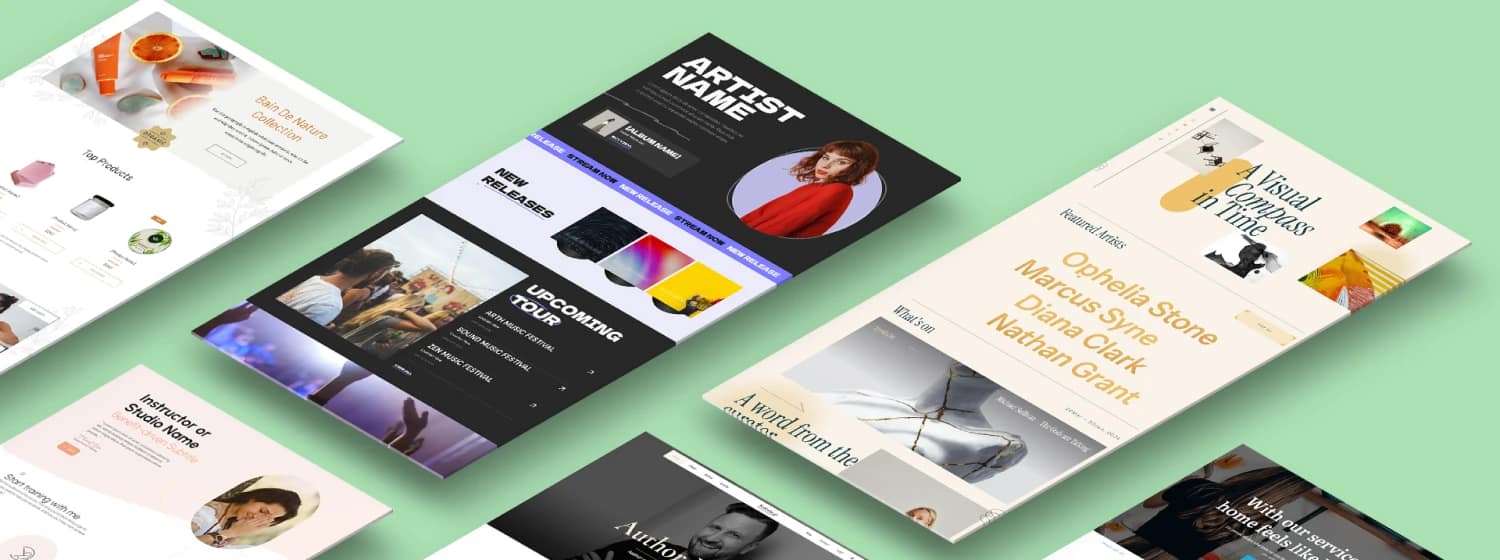📌 TL;DR: “Do I really need a personal brand if I already have a business?”
Short answer? Yes. Because personal branding for entrepreneurs isn’t just about getting seen. It’s about being trusted, being remembered, and building the kind of credibility that drives conversions long before a sales call ever happens.
In today’s market, your face is your funnel. When done right, your personal brand:
Turns your story into strategic positioning
Builds trust faster than any ad campaign
Attracts leads, referrals, partnerships, and press — without cold pitching
Becomes the emotional edge that separates your business from lookalikes
This article breaks down the exact steps to build a personal brand that actually performs — from clarifying your value proposition to creating a conversion-optimized personal website (yes, Thrive Architect makes this easy), and crafting content that builds long-term authority.
If you’re the founder, face, or heartbeat of your business — your personal brand is not a side project. It is your brand.
You don’t get to opt out of personal branding. If you’ve ever been Googled, stalked on LinkedIn, or casually introduced at a networking event, you already have one.
The only question is whether it’s intentional… or accidental.
Here’s the part most entrepreneurs underestimate:
Your personal brand is your business’s brand.
People aren’t just evaluating your offer — they’re evaluating you. And in today’s market, a polished pitch isn’t enough. What moves people is trust, visibility, and a clear value proposition.
The data backs it up:
As an introvert at heart, I get it — showing up online can feel like a lot. But I wouldn’t have the digital career I do if I hadn’t taken personal branding seriously. It’s how people found me, trusted me, and hired me — even when I wasn’t the loudest voice in the room.
“Your personal brand is your reputation. And your reputation in perpetuity is the foundation of your career.”
— Gary Vaynerchuk
That’s why building an authentic personal brand isn’t just smart — it’s essential. Whether you're growing a business, launching a new offer, or stepping into thought leadership, your brand is how people connect with you, remember you, and believe in your work.
In this guide, we’ll break down how to:
- Define your entrepreneur identity
- Use storytelling for business to build trust
- Show up with consistent messaging across platforms
- Craft a high-converting personal website using Thrive Architect
- And position yourself with brand visibility that lasts
Because in a world full of noise, clarity is your edge.
This is how you become the brand people trust — and the person they want to work with.
Ready to shape a brand that reflects who you are and drives results?
Let’s get into it.
What Do I Need to Know to Build a Personal Brand That Converts?
If you’re an entrepreneur, your personal brand is your reputation, your pitch, and your proof — all rolled into one. This section covers the essentials: what it looks like, how to build it, and how to know when it’s working.
It looks like you – just more focused.
A good personal brand doesn’t mean sounding polished all the time or pretending to be bigger than you are. It means showing up with:
- A consistent voice and style across your website, social content, and offers
- A clear value proposition: who you help, how you help them, and why it matters
- A tone that feels real. Not robotic, not overly filtered, and definitely not copied from ChatGPT
If someone lands on your site or profile, they should immediately get what you're about and trust that you know what you're doing.
Start with what’s already working.
- What do people ask you for help with?
- What kind of problems are you great at solving?
- What results or outcomes do your clients rave about?
Your entrepreneur identity is probably already in motion. This step is just about getting clear, so you can communicate it on purpose. That clarity makes every piece of content and every pitch feel more aligned and more effective.
You don’t need to be louder. Focus on being clearer.
- Focus on helping, not pitching
- Tell honest stories about what you’ve learned, who you’ve helped, and how you think
- Let your personality show – dry humor, niche obsessions, awkward analogies included
This kind of storytelling for business builds real trust because it’s relatable. You’re not trying to impress. You’re here to connect.
Wherever your people already are.
- Start with 1–2 places where your niche audience hangs out (LinkedIn, YouTube, podcasts, etc.)
- Use your personal website as your anchor — the one place you fully control
- Point everything else (social posts, podcast interviews, guest features) back to that hub
🛠️ Want to make your site conversion-focused and easy to update? Build it with Thrive Architect.
You don’t need to post daily or write a manifesto. You just need to be useful and consistent.
- Teach something that solves a real problem
- Share quick wins, lessons learned, and transformation stories
- Stick to a tone and message that matches your brand — whether that’s bold, calm, quirky, or straight-talking
A strong content strategy gives people a reason to come back — and something to share when they recommend you.
It’s not just a vibe — it’s measurable.
- You get referrals, invites, or messages from people who already feel like they know you
- People share your content, quote your ideas, or tag you in the right conversations
- You can track opt-ins, inquiries, and engagement tied directly to your content or website
What Happens If You Ignore Personal Branding?
Most entrepreneurs don’t think about personal branding until it’s too late.
They launch the business, build the offer, set up the site – and only *then* start wondering why no one’s paying attention, why they're being overlooked, or why people don’t get what they do.
But here’s the hard truth: if you're not actively shaping your personal brand, people will fill in the blanks for you – and they usually get it wrong.
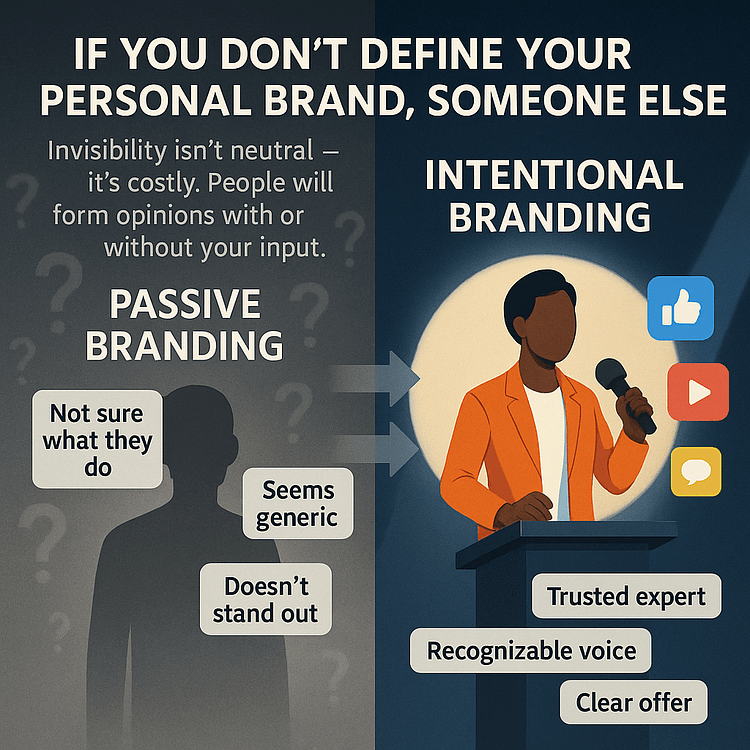
This section breaks down the silent (but serious) ways a weak or non-existent personal brand can hurt your business. Not in theory, but in revenue, reach, and relevance.
Let’s take a look at what’s really at stake when you leave your brand on autopilot.
I have a decent website and some good headshots. Is that enough for a personal brand?
Not quite.
A clean website and nice visuals are a good start but they’re not the whole picture. A personal brand isn’t just about how things look. It’s about how people feel when they come across your name.
People don’t buy from logos. Nope. They buy from people they trust. And trust doesn’t come from mere polish. It comes from clarity, consistency, and connection.
If your message is vague, your audience won’t know what you stand for. If your voice is missing, your content feels generic. If your story isn’t being told, someone else fills in the gaps… or they move on to someone who makes it easier to understand what they’re about.
Looking professional might get you in the door. But a strong personal brand is what keeps people interested — and gets them to say yes.
What do I risk by not building a personal brand?
You risk being invisible — even when you're doing great work.
Without a clear personal brand, you don’t stand out. You blend in. And when people can’t quickly understand who you are, what you do, or why you’re different, they move on — even if you’re the perfect fit.
That means:
- You get filtered out of opportunities before you’re even considered
- You end up competing on price, because no one sees the full value of your expertise
- You keep repeating your story from scratch — in DMs, on calls, in pitches — because nothing online does the heavy lifting for you
A personal brand gives you leverage. Without it, you’re stuck doing all the work manually — every single time.
Does my personal brand really need to show up on Google?
Yes, because that’s where people look *first*.
Before someone replies to your email, books a call, or says yes to your offer, they’re probably searching your name. If what they find is outdated, inconsistent, or nonexistent, it sends the wrong message — or no message at all.
Think about it:
- No search results? You might seem inexperienced.
- A half-baked LinkedIn with no photo? You might seem untrustworthy.
- A forgotten blog from 2017? You might seem out of touch.
Your online reputation is part of your personal brand. And if you don’t control what shows up on Google, someone else — or silence — will.
Showing up doesn’t mean you need to be famous. It means being *findable* in a way that backs up what you say you do — and gives people a reason to take the next step.
😬 Why This Hurts More Than You Think
“When you don’t shape your personal brand, the world fills in the blanks for you — and they usually get it wrong.”
Staying quiet might feel safe, but it comes at a cost.
You miss out on clients — not because you lack talent, but because someone else showed up with a clearer message. You get undervalued, overlooked, or underpaid, simply because your external image doesn’t match your internal skillset. And over time, that gap chips away at your confidence — hello, imposter syndrome.
Here’s the uncomfortable truth: Visibility beats talent — every time. People don’t hire the “best-kept secret.” They hire the person they know about. They hire the person who owns their space, tells their story, and makes it easy to say yes.
That’s not unfair. That’s branding. And if you don’t control your narrative, someone else will — or worse, no one will care enough to try.
💡 Want to shape a personal brand that earns trust — not just likes? 👉 Start building your personal brand hub with Thrive Architect
A Conversion-Focused Plan to Build Your Personal Brand
Now that you know what’s at stake, let’s talk about how to actually build a personal brand that works for visibility *and* growth.
This isn’t about checking off branding to-dos. It’s about creating a clear, consistent presence that builds trust, drives action, and supports your business goals at every step.
The good news? You don’t need to do it all at once — and you definitely don’t need to be everywhere. What you *do* need is a smart strategy, the right tools, and a brand that shows up the same way you do: confidently, consistently, and with purpose.
Here’s how to build it — step by step.
Step 1: Audit Your Brand (Start with the Mirror Test)
Before you can shape your authentic personal brand, you need to understand what people already see — and where there’s a disconnect.
This is your foundation. Your entrepreneur identity already exists online, whether you’ve built it intentionally or not. And that means your online reputation is doing some of the talking for you.
Start with a quick reality check:
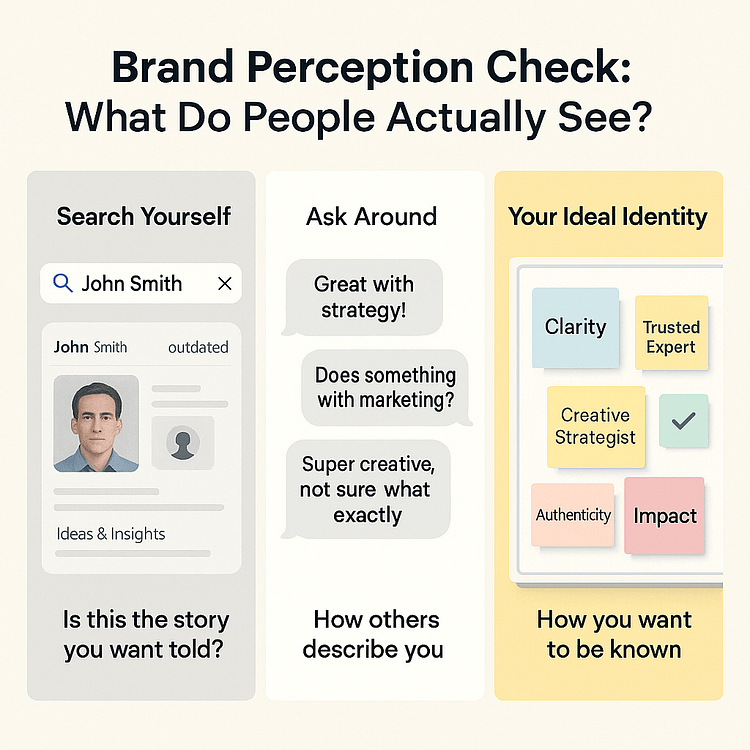
Here’s what shows up when I Google myself. Not too bad:
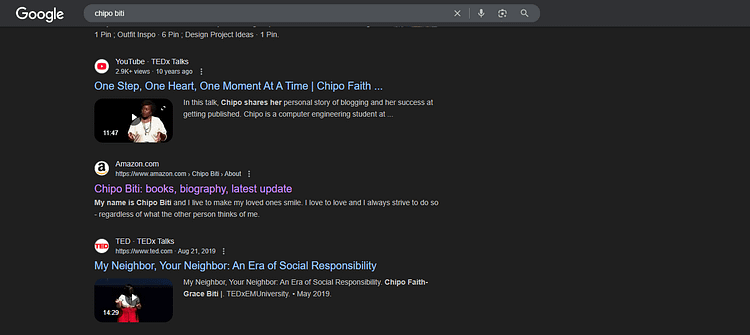
And when I use my “professional” name, Chipo Faith, this is what shows up:
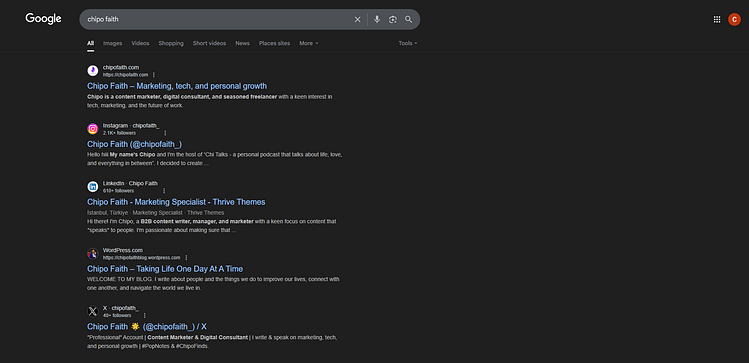
My website first. Then my social pages. It’s easy for anyone to learn about me in seconds.
This isn’t about judging what’s there. The goal here is to notice the gaps between your current perception and your ideal entrepreneur identity. Once you know where you stand, you can start building with purpose.
Step 2: Make Your Value Proposition Clear
If your personal brand doesn’t tell people what you actually *do* – and who it’s for – they’re not going to stick around to figure it out.
Your value proposition is the heartbeat of your brand. It’s the bridge between your skills and someone else’s pain point. And it needs to be crystal clear to your niche audience.
It should answer three simple questions:
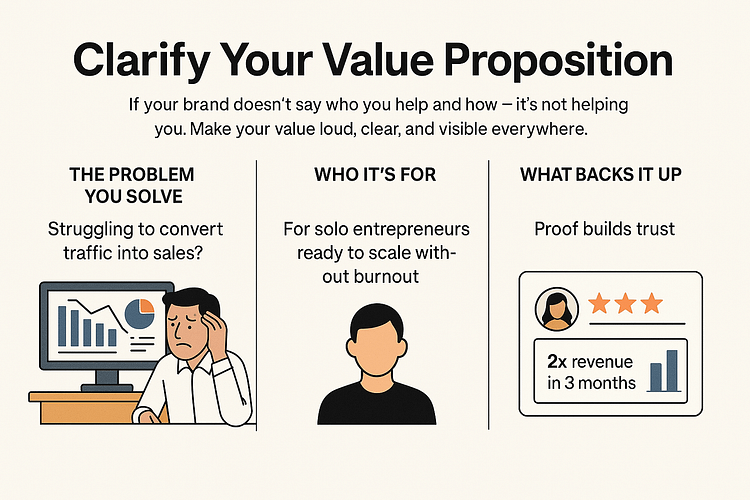
Once you have this message, use it *everywhere*:
This is how you go from “interesting” to *essential*. From noise to thought leadership. From clicks to conversions.
Keep it simple, keep it true, and keep it consistent.
Step 3: Create Your Brand Home Base (Personal Website)
Social platforms come and go, but your personal website is where your entrepreneur identity lives and grows.
It’s the one digital space you fully control. No algorithms. No noise. Just your professional image, your message, and a clear path to action.
If you don’t already have one, this is where Thrive Architect makes it easy. You can launch a sleek, conversion-focused website in hours.
A strong personal site gives you:

At a minimum, include:
🛠️ Want help building it?
Check out our guide on how to build your personal brand site with Thrive→
Step 4: Be Consistently Present on the Right Platforms
You don’t need to be everywhere. So breathe. *Whew.*
You just need to be where it counts.
Pick 1 - 2 social platforms where your audience already spends time. You could choose LinkedIn, Instagram, YouTube, or even podcasts. The goal isn’t to chase trends, but to be discoverable and present where real conversations happen.
Once you’ve picked your primary channels, the key is consistent messaging. You’re not starting from scratch every time. What you’re doing here is reinforcing your entrepreneur identity and building brand recognition through repetition.
Try this:
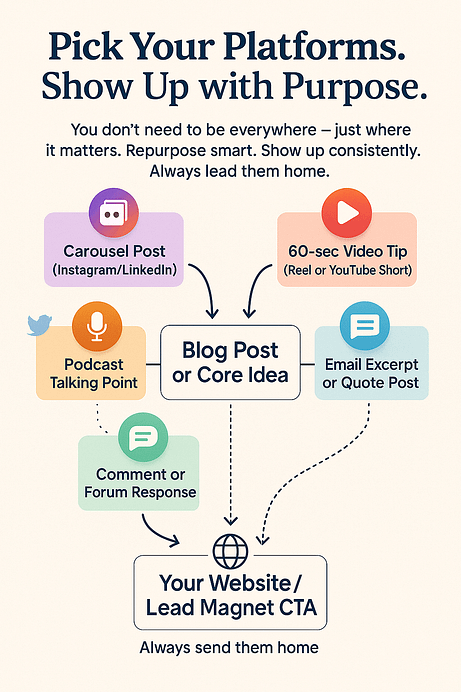
And always link back to your personal website or lead magnet. Every post, comment, or video should connect your audience to your brand hub — the place where your authentic personal brand lives and where conversions happen.
💡 Pro tip:
Want to amplify your social media branding and increase brand visibility even more?
Embed a live social media feed on your homepage. It instantly makes your website feel active and current, while giving visitors a peek into your day-to-day tone, personality, and thought leadership — all without leaving your site.
👉 Learn how to do it (and which tools work best) in this guide:
How to Add a Social Media Feed to Your WordPress Website
Because if you want to build trust online, you have to show up — clearly, consistently, and in the spaces where your audience is already paying attention.
Step 5: Build Authority Through Content and Conversation
I’ll be honest: I used to think “authority” meant sounding ultra-polished or posting every day. It doesn’t. Some of the most powerful authentic personal brands I know are built on just a few high-trust habits.
Here’s what actually works:
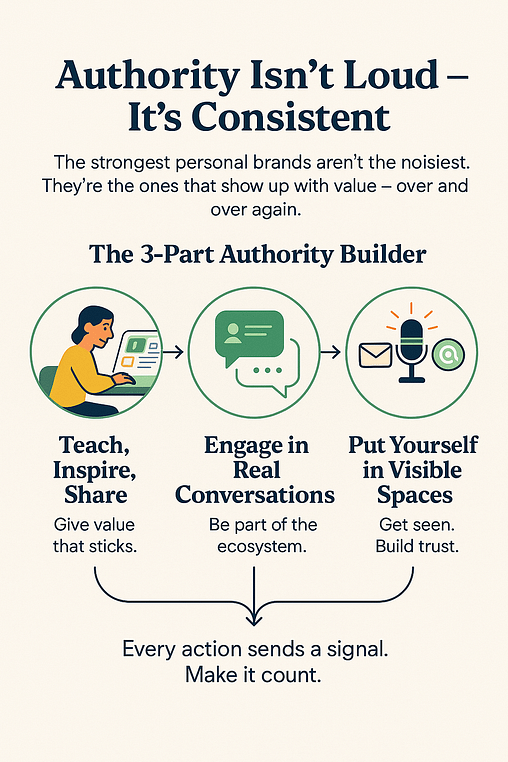
Every post, comment, or article is like a little signal: “Hey, I’m here. I care. I can help.”
Do it with consistent messaging and real intention, and your audience won’t just recognize your name, they’ll trust it. That’s how you build trust online and become the go-to person in your space.
Step 6: Use Feedback and Data to Evolve
You’re not the same person you were six months ago — and your personal brand shouldn’t be either.
As your business grows, your perspective sharpens. Your offers shift. The way you talk about your work gets clearer. That’s not a problem — that’s progress. But if your online reputation hasn’t caught up, it might be holding you back.
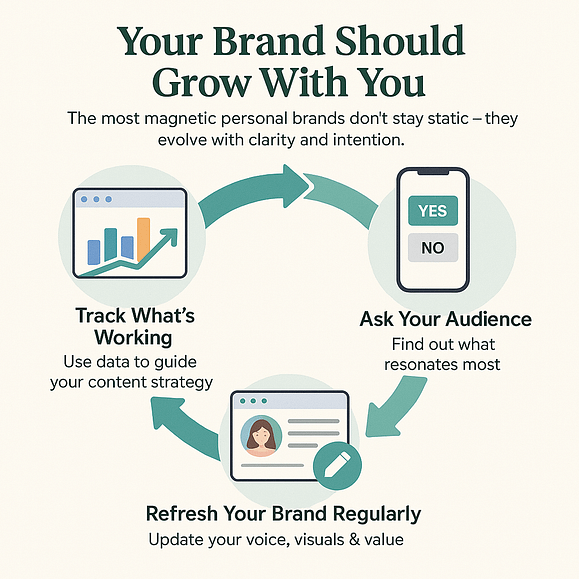
When your brand evolves with intention, it doesn’t just stay relevant — it becomes magnetic. It’s how you maintain brand visibility and keep showing up with clarity, not confusion.
BONUS: What If I’m Growing Fast — or Starting Over?
Personal branding isn’t a one-and-done task — it’s a living part of your business. As your audience grows, your team expands, or your goals shift, your brand needs to evolve with you.
But growth brings tension: How do you stay true to your voice when others start creating for you? How do you pivot or rebrand without losing the people who already believe in you?
Here’s how to keep your brand grounded in *you* — even as everything around you changes.
How do I scale my brand without losing authenticity?
As your audience gets bigger, your offers expand, or you start bringing in help, it gets harder to keep everything feeling like *you*.
How do you stay consistent when other people start writing on your behalf?
How do you shift direction without confusing the folks who’ve been with you from the start?
This part is tricky but it’s also where your brand gets stronger.
Let’s talk about how to grow without losing your voice, and evolve without losing your people.
Scaling shouldn’t flatten your voice — it should *amplify* it. When your team knows how to speak your language, your message becomes more powerful, not diluted.
How do I rebrand without confusing my audience?
Maybe you’ve outgrown your original niche. Maybe your business model has shifted. Or maybe you’ve simply evolved — and your current brand no longer reflects who you are or what you do.
That’s normal. But if you don’t bring your audience along for the ride, they’ll feel left behind — or worse, tune out entirely.
Here’s how to make a smooth, confident shift:
Rebranding isn’t about becoming someone else. It’s about aligning your outer presence with who you’ve already become. When done well, it doesn’t confuse your audience — it reminds them why they trusted you in the first place.
🙋 FAQ: Personal Branding for Entrepreneurs
It’s the intentional act of shaping how people see and remember you — especially across your digital presence. A strong personal brand builds trust, elevates your online reputation, and turns brand visibility into real business opportunities. It’s about creating an identity that reflects your values and positions you as a trusted voice in your niche.
Yes — absolutely. Your entrepreneur identity shows up anywhere your name appears: Google search results, your personal website, Zoom meetings, podcast guest spots, even your email signature. Social media is a great amplifier, but your brand exists with or without it — and it matters even more if you rely on word-of-mouth marketing or referrals.
Shift your focus to thought leadership and connection. Your brand isn’t about hyping yourself — it’s about helping others. When you teach, share lessons learned, or tell relatable stories, you build trust without ever sounding like you’re bragging. That’s what real authority building looks like.
Your business brand highlights your products, services, and offers. Your personal brand showcases the human behind the business — your voice, mission, and perspective. The two often overlap, but it’s your personal brand that usually sparks the first connection and drives long-term loyalty.
🧠 Conclusion: Your Brand Is the Bridge Between Who You Are and What You Offer
Your business might evolve. Your offers might shift. But your personal brand? That’s what keeps people listening, trusting, and coming back.
This isn’t about ego. It’s about resonance.
Your personal brand is the emotional engine behind your business — the reason people choose *you* over someone with the same skills or services. It’s what builds trust, creates momentum, and keeps working long after the ads stop running.
So don’t leave it to chance. Don’t wait for someone else to define you.
Shape the mirror. Make it reflect the version of you that’s ready to lead.
💡 Final CTA:
Want to build a personal brand site that reflects exactly who you are — and turns clicks into conversions?
→ Launch it today with Thrive Architect.

